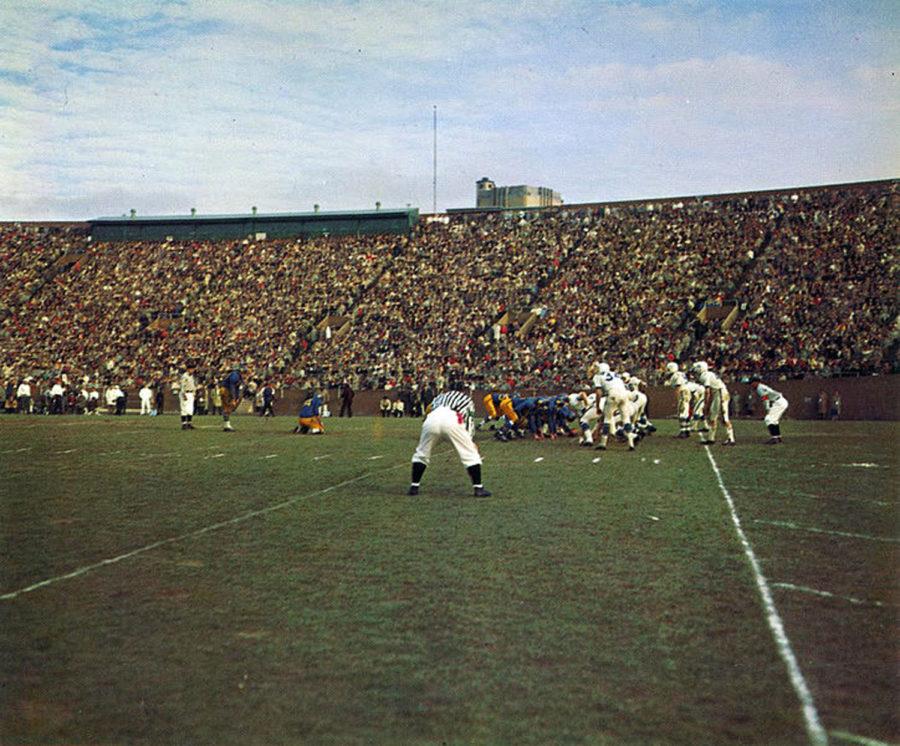Keystone contest: Pitt and Penn State’s football rivalry through the years
The Pitt and Penn State football teams face off in Pitt Stadium on November 27, 1958. (Image via Wikimedia Commons)
September 5, 2018
The long-standing rivalry between Pitt and Penn State is a centerpiece of more than a century of college football. Of the 98 games played so far, Penn State holds the advantage with 51 wins to Pitt’s 43, with the teams also tying four times. With the 99th edition this Saturday, fans of both teams are gearing up for yet another electrifying and crucial game that will prepare both teams for the season ahead. The re-emergence of this in-state rivalry in 2016 after a 16-year hiatus brought an increased focus to the game and its impact for both teams.
In honor of Saturday’s upcoming game, here’s a look at some of the most pivotal points of the series since its inception in 1893.
Western University of Pennsylvania — the school was not named the University of Pittsburgh until 1908 — and Penn State took the field in State College to face each other for the first time Nov. 6, 1893 — four years after students Bert Smyers and John Scott founded the WUP football team, and six years after the Penn State team was founded. Penn State won decisively, 32-0, in the first installment. This victory embodied the early stages of the rivalry, as Penn State would go on to dominate the series for the first 15 years, winning 12 of those matchups.
Pitt showed its worth in the rivalry when the team kicked off a victorious era in 1922. A 14-0 Panthers win Nov. 30, 1922, began a 14-game win streak that lasted until 1938. The streak is still the longest by either team in the series. This 16-year span began the evolution of the Pitt football team into a college football powerhouse and one of the most influential teams in the eastern United States, highlighted by five National Championship victories. The team reached its pinnacle with an undefeated, National Championship-winning season in 1937.
Nearly 40 years passed before the Panthers had their next shot at a championship. Ranked No. 1 and undefeated in 1976, Pitt just had to beat Penn State to secure its place in the Sugar Bowl and a shot to play Georgia for the national title. An evenly played first half ended at 7-7, but Pitt came out in the third quarter intent on victory. Heisman Trophy winner Tony Dorsett racked up 173 second-half rushing yards, leading the Panthers to a crucial 24-7 victory.
The teams’ 1981 matchup perfectly displayed the back-and-forth nature of the rivalry. Just as in 1976, Pitt came in undefeated and needing to beat Penn State in late November to secure its place in the National Championship. The game was tied at halftime once again, 14-14 — but this time Penn State came out hungry in the second half.
The Nittany Lions silenced the Panthers’ Dan Marino-led offense during a dominant second half on their way to a 48-14 win. This victory sparked a run of success for Penn State, as they won the National Championship in both 1982 and 1986.
In their last meeting before the 16-year hiatus — which occurred due to conference restructuring and obligations — Pitt claimed a 12-0 victory on Sept. 16, 2000. The ensuing period seemed to bring a lack of tenacity in the play of both teams with the absence of the rivalry, as an entire generation of fans on both sides didn’t get to experience the crucial late-season games that brought about bragging rights and a feeling of greatness.
That all changed in 2012, when Pitt Athletic Director Steve Pederson announced a revival of the rivalry through a four-game series in 2016 to 2019. An air of excitement returned to both fan bases with the prospect of inaugural bragging rights on the line. The rivalry resumed at Heinz Field Sept. 10, 2016, and did not disappoint.
After gaining a 28-7 lead, Pitt allowed a late Penn State comeback and just barely held on for a nail-biting 42-39 victory. It was a highly competitive contest in an extremely charged atmosphere, as the 69,983 fans in attendance marked the most in Pittsburgh history. The game showed a new generation the impact of the rivalry and its importance to Pennsylvania and college football as a whole.
Penn State took the second game of this new series decidedly at Beaver Stadium, winning 33-14. Penn State’s attitude toward the revival has generally been one of dismissal, with head coach James Franklin even stating it was “just like beating Akron,” dismissing it as though it were just any other game on the schedule.
Despite what Penn State fans say, this matchup tends to have a huge impact on both teams’ season outcomes. There is a direct correlation between the results of the rivalry games and how each respective program performs that season. Pitt’s greatest era from 1922 to 1938 featured complete dominance in the games against Penn State. Conversely, Penn State outplayed Pitt in the series (going 32-13-2) between 1952 and 2000, and also became more nationally relevant with two national championships.
Saturday’s game will undoubtedly add to this rich history — but even more exciting, the game has the chance to directly affect how both teams perform this season, as has happened year in and year out since the rivalry’s inception more than 100 years ago.








